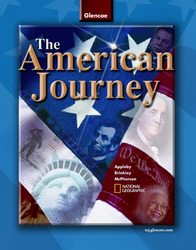
The American Journey © 2007Chapter 18: The Western FrontierChapter OverviewsAs the California Gold Rush was ending, mining expeditions discovered gold and other precious metals in other parts of the West. The gold strikes created boomtowns that were lively, often lawless places. Transportation played a vital role in the survival of mining communities, and in the 1850s the search for a route for a transcontinental rail line began. Coal producers, railroad car manufacturers, and construction companies flourished as the railroads spread across the West. Other changes came to the West with the growth of cattle ranching. African American, Native American, Hispanic, and Anglo cowhands all worked together on the long cattle drives. The Homestead Act, railroads, and new farming methods all drew settlers to the Great Plains. As new settlers poured into the West they came into conflict with the Native Americans who had made their homes there for centuries. Hoping to avoid violence, the government approved new policies to move all of the Native Americans onto reservations. A great many Native Americans accepted the reservation policy; however, pockets of resistance remained. After many years of violence, the conflict at Wounded Knee marked the end of armed conflict between whites and Native Americans. Although farming expanded following the Civil War, problems for farmers also grew. Several attempts were made to form organizations to improve the lives of farm families, including the Grange and Farmers' Alliances. In 1892 one such group formed a third political party—the Populist Party. Although the party faded following the presidential election of 1896, many of its reforms were adopted. |  |















